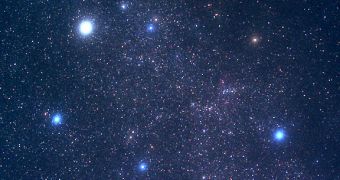At the center of the Auriga constellation lies one of the weirdest star systems in the universe, Epsilon Aurigae, an F-type star about 389 million kilometers across that is being eclipsed every 27 years by an even larger disk of matter orbiting around it. That particular object could just as well become one of the greatest structures in the universe and is believed to house two small stars in the middle, a black hole or a single large star that pulled material from Epsilon Aurigae with the help of a powerful gravitational field to create the disk-like structure.
The next eclipse will begin in August 2009 and will end in May 2011, during which time astronomers expect to observe an interaction between the star, the cloud of gas and a third object. "It has prospects to produce a bit of fireworks by mid-century", said Robert Stencel, professor of astronomy at the University of Denver.
A decade ago the Epsilon Aurigae variable star experienced an increase in the brightness variability cycle from 96 to 67 days, but until now no one was able to explain what had triggered it. "It's a simple extrapolation to say that if over the course of one decade we see this much change, then within a few decades some kind of punctuation may be coming along", said Stencel.
Also, the observations carried out during the last eclipse revealed that it has shrunk by half a percent every year, suggesting that the system may be affected by the orbital motion of a planet embryo falling towards the supergiant star. As this happens its orbit steadily shortens, causing it to pass faster in the front of the star, which could also explain why the brightness variation shortened in time.
Ultimately the embryo will collide with the large cloud of the star, to create a bright flare similar to those observed in interacting binaries and recurring novas, as mass is being siphoned from one star to the other until it reaches a critical level and goes nova. According to experts, the flare would be so powerful that it could be visible from Earth with the naked eye.
"That could pop it up to become one of the brightest objects in the sky", said Stencel.
On the other hand, Edward Guinan, astrophysicist at the Villanova University says that if the gas structure is somehow interacting with an unobserved planetesimal, the inner part of the disk will explode onto the object in its center.
At the time of the last eclipse there were no instruments powerful enough to observe the dark object orbiting around the Epsilon Aurigae system, although in 2009 the Hubble Space Telescope could be used to make detailed observations of the system.
"We're trying to promote the idea that here's this singular event kind of on the scale of a Halley's comet. We invite people to observe it and report to their local science centers and help us collect some data", Stencel said.

 14 DAY TRIAL //
14 DAY TRIAL //